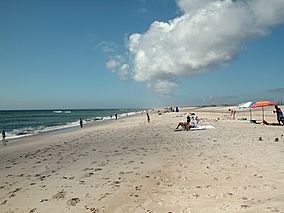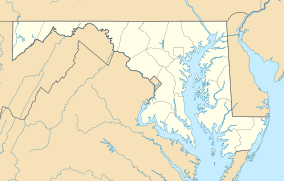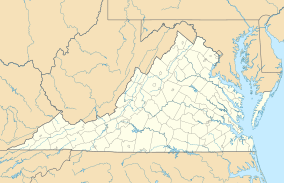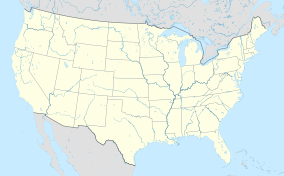Assateague Island National Seashore facts for kids
Quick facts for kids Assateague Island National Seashore |
|
|---|---|
|
IUCN Category V (Protected Landscape/Seascape)
|
|

View of a beach on Assateague Island
|
|
| Location | Worcester County, Maryland & Accomack County, Virginia, USA |
| Nearest city | Ocean City, MD & Chincoteague, VA |
| Area | 41,320 acres (167.2 km2) |
| Authorized | January 1, 1965 |
| Visitors | 2,105,419 (in 2011) |
| Governing body | National Park Service |
| Website | Assateague Island National Seashore |
Assateague Island National Seashore is a special place managed by the National Park Service in the United States. It's located on the East Coast along the Atlantic Ocean. This beautiful island stretches across parts of Maryland and Virginia.
Assateague Island is a large, natural barrier island. This means it's a long, narrow island that protects the mainland from ocean storms. It's mostly untouched by human buildings. The park's main goal is to protect its unique coastal areas and natural environment. It also offers fun activities for visitors. Plus, it teaches people about how important this area is.
Assateague Island is about 37 miles long. It includes the island itself, nearby marsh islands, and the surrounding waters. The park covers over 41,000 acres of land and water. The island has three main public areas. These are Assateague Island National Seashore, Assateague State Park, and Chincoteague National Wildlife Refuge. Each area is managed by different groups.
Contents
Exploring Assateague Island
Assateague Island is a barrier island shaped by strong ocean waves and gentle winds. It is about 37 miles long but never more than a mile wide. The park is split into two main parts: the Maryland District in the north and the Virginia District in the south. You cannot drive from one end of the island to the other. To visit both parts, you must drive back to the mainland and then to the other side.
Maryland's Side of Assateague
The Maryland part of Assateague Island goes from the Ocean City Inlet down to the Virginia state line. Here, you'll find the main visitor center for Assateague Island National Seashore. There are also campgrounds, nature trails, and a beach with lifeguards. The smaller Assateague State Park is also in this area. You can only get to the Maryland side by crossing the Verrazano Bridge on Maryland Route 611.
Virginia's Side of Assateague
The Virginia part of Assateague Island starts at the Maryland state line and goes south to the Chincoteague Inlet. This area is known as the Chincoteague National Wildlife Refuge. It is managed by the U.S. Fish and Wildlife Service. However, the National Park Service also helps out here. They manage a recreational beach and a lifeguarded area for visitors. This teamwork helps protect the wildlife while still allowing people to enjoy the beach.
The Chincoteague National Wildlife Refuge is on the southern end of Assateague Island. Don't confuse it with Chincoteague Island, which is a nearby island with homes and businesses. To reach the Virginia side of Assateague, you must drive through Chincoteague Island first.
How the Island Changes
Assateague Island is part of a long chain of barrier islands. These islands stretch all the way from Maine to Texas. The island is built from sand that moves south along the coast. This sand comes from erosion in the Appalachian Mountains.
The island is slowly moving westward because of natural processes and storms. Water washes over the island during storms, pushing sand backward towards the bay. This is called "barrier island rollover." It's happening faster now because of climate change and rising sea levels. This change is most noticeable at the northern end of the island. Here, jetties built for Ocean City have stopped new sand from reaching Assateague. This means Assateague's beach has shifted hundreds of meters west compared to Ocean City's.
History of Assateague
Before it became a national seashore in 1965, people planned to turn Assateague Island into a private resort. This resort was going to be called Ocean Beach, Maryland. In the 1950s, about 5,000 private lots were sold for building homes.
However, the Ash Wednesday Storm of 1962 stopped these plans. This powerful storm destroyed the few buildings that were already on the island. It also ripped apart the roads. People then realized that the island was too unstable to build on. So, the company that owned the land sold it all to the United States government. This is why you still can't drive the entire length of the island today. You have to travel on the mainland to go between the Maryland and Virginia parts.
Fun Things to Do
Since the park was created, many improvements have been made for visitors. A two-mile road on the island helps people reach the National Seashore. A new visitor center was built in 2010 on the mainland. It gives visitors information and exhibits before they cross the bridge to the island. Many ranger-led programs are offered in the summer and fall.
Camping Adventures
The park has 148 campsites for tents and RVs. On the Maryland side, you can choose between oceanside or bayside campsites. Oceanside sites are close to the beach and ocean. Bayside sites offer great views of the wetlands, where horses often graze.
The park also has six backcountry camping sites. Four of these are on the bayside and can be reached by canoe, kayak, or hiking. Two are oceanside sites that you hike to. There is no fresh water at these backcountry sites. Be aware that bayside sites can have many biting insects in the summer. There is no camping on the Virginia side of the island. However, there are campgrounds in the town of Chincoteague and on the mainland nearby.
You need to make reservations for most campsites. You can book online or by calling 1-877-444-6777. Reservations open six months ahead of time and fill up quickly, especially for weekends and holidays.
Hiking Trails
The national seashore has three short nature trails, each less than a mile long.
- The Marsh Trail is a half-mile trail on a raised boardwalk. It goes over the marsh and offers great views of the salt marsh habitat. This trail can offer some relief from mosquitoes.
- The Forest Trail is also a half-mile long. It has an easy-to-walk surface and boardwalks. Much of this trail is shaded by trees, which helps keep you cool.
- The Dunes Trail is three-quarters of a mile long, and you walk entirely in the sand. This trail lets you see many different plants that grow in this sandy environment. It also includes a part of Baltimore Boulevard, a road that was destroyed in the 1962 storm.
Swimming and Surfing
You can swim anywhere in the ocean at Assateague. However, the National Park Service provides lifeguarded beaches in both Maryland and Virginia. During the summer, lifeguards are on duty from 10 a.m. to 5 p.m. The national seashore is also a popular spot for surfers. But remember, surfing is not allowed in the lifeguarded areas.
Fishing Fun
Saltwater fishing is a very popular activity here. If you are 16 or older, you need a valid fishing license to fish in Maryland or Virginia. Since 2011, all anglers must buy a Maryland fishing license before fishing.
Driving on the Sand
The over-sand vehicle (OSV) zone is a special area where four-wheel drive vehicles can drive on the beach. The Maryland OSV zone goes from the main camping area to the Virginia state line. A fence for the horses stops vehicles from going into the national refuge. You need a permit and special safety equipment to drive in the OSV zone.
Only a certain number of vehicles are allowed in the OSV zone at one time. In Maryland, it's limited to 145 vehicles, controlled by automatic gates. In Virginia, it's 48 vehicles, or 18 if a certain area is closed. OSV permits last for a year from the purchase month. The cost ranges from $70 to $150, depending on the type of access you want. All vehicles in the OSV zone must show a valid permit. When you get a permit, you agree to know and follow all OSV rules.
Wildlife and Nature
Assateague Island National Seashore is home to many plants and animals. These creatures have adapted to live in this unique coastal environment. The salt marsh areas attract many wading birds, seabirds, and mammals.
Amazing Birds
You'll see many shorebirds and wading birds at Assateague. Some birds that nest here include piping plovers, great egrets, and red-winged blackbirds. Seabirds like brown pelicans and different kinds of gulls and terns are also common. In wooded areas, you might spot ruby-crowned kinglets and white-eyed vireos. During winter, northern birds like brant geese and northern saw-whet owls come to the area.
The park must protect endangered species, like the Piping Plover. These birds are listed as a threatened species. During their summer breeding time, parts of the OSV zone and the north end of the island are often closed. This helps protect their nests and newborn chicks from being disturbed.
Wild Horses of Assateague
Bands of wild horses, often called Chincoteague ponies or Assateague horses, live freely on the island. A local story says these horses came from a shipwreck long ago. But it's more likely they are descendants of horses that local people kept on the island to avoid paying taxes on fences on the mainland. Their diet of salty marsh grasses makes them short and gives them bloated bellies.
Two separate herds of horses live on the island, divided by a fence at the Maryland-Virginia border. The horses in Virginia are owned by the Chincoteague Fire Department. These are the famous ponies that are rounded up every July. They then swim to nearby Chincoteague Island for a fundraiser called "Pony Penning." The firefighters give them food, water, and vet care to keep them healthy for the auction. The Maryland herd is treated as wild animals. They are not rounded up or removed from the island, and they don't receive veterinary care.
Even though many of the horses on the island are short (under 4 feet 8 inches), they are considered horses, not ponies. This is because their ancestors were horse breeds. Their small size is due to their salty diet.
The horses, especially those near developed areas, might seem friendly. But they are wild animals and can bite or kick visitors. It's important to be careful around them. Park rangers may give tickets to visitors who pet, feed, or get closer than 40 feet to the horses.
Fees and Passes
There are fees to enter Assateague Island National Seashore. These fees are for each car and also work at Chincoteague National Wildlife Refuge in Virginia. The park also accepts all types of Federal Recreational Lands passes. These include passes for seniors, military members, and people with disabilities. The pass holder must be in the vehicle for the pass to be valid. You can find a full list of fees online.
Gallery
-
Sign at the entrance from Chincoteague













